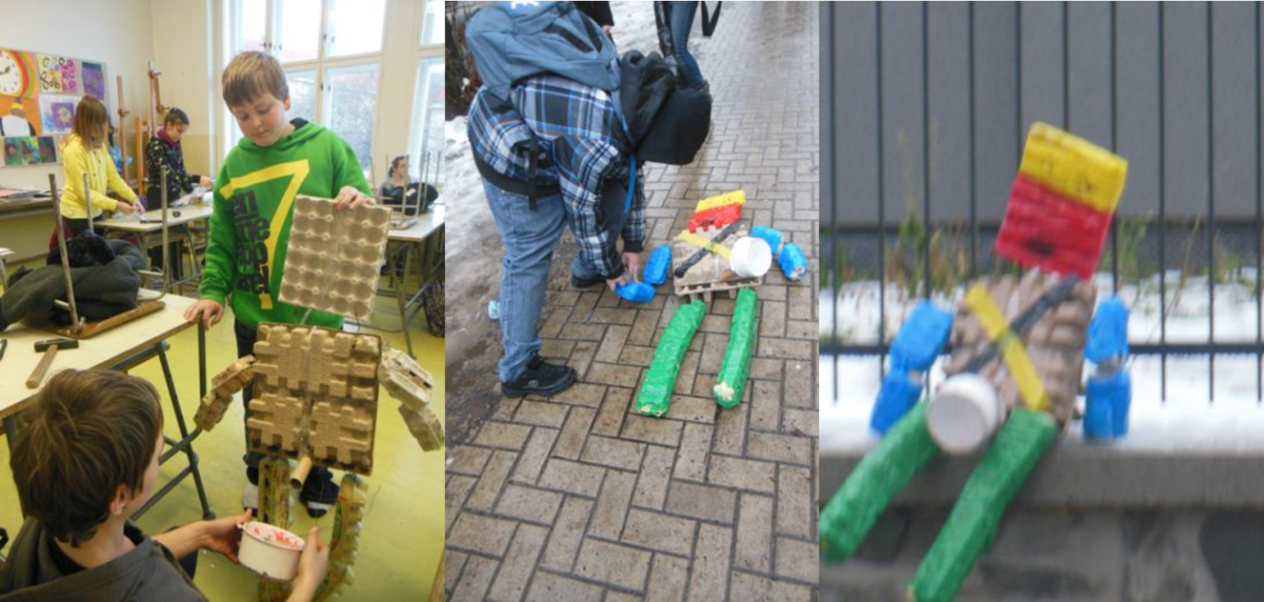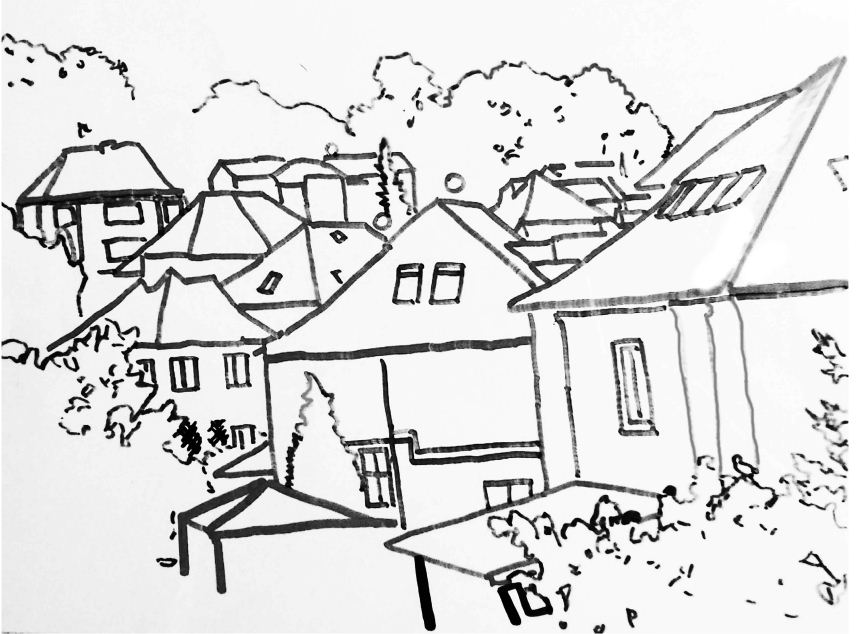Czech Lesson Plan
Scheme of work: My city – my space
Recommended Age Group: 12 – 14
Timescale: 90 min
Country: Czech Republic
Project School: ZS Palachova
Conceptual Framework
Children from the second stage of elementary school were involved in this project, “My city – my space”. The art project took place over a half-year period and focused on the city Ústí nad Labem. Pupils examined and reflected on the place where they live, its history, neighbourhood, present and past problems. The pupils learned how to express facts and their feelings about all the issues through visual means. The major aim of the work was to build pupil’s awareness of self-identity and their self-confidence through a good understanding of their home city. Themes of the project were:
- Folk costume for the 21.century,
- Industrial architecture,
- Legends from the region,
- Traditional regional brands,
- Architectural detail,
- Landscape and its soul,
- Fragments of the landscape,
- Bridges of Ústí,
- Masks,
- ‘Strange’ people from our city,
- Journeys in the city,
- Where does your family come from?
The city of Ústí nad Labem (in German: Aussig) has a very complicated history and is situated in one of the poorest regions of Czech Republic. The region witnessed many drastic changes in the 20th century and there is now a problematic social situation in this area, which is due to its history as a ‘wild land’. Today’s children are often the first generation born here. They do not feel as rooted as their parents do, but they are discovering how they belong as part of a very complicated process.
The activities developed by this project are easily transferable for use with pupils in other cities or places in Europe, as many of the underlying social concepts and broader issues are commonplace for many children and young people.
Instructions for Activities
Lesson 1: ‘Strange’ people from our city
Key words
- My space,
- Identity,
- People,
- City,
- Home,
- Norms and system.
Resources
- paper,
- recycled materials (boxes, cans, bottles etc.),
- scissors,
- glue,
- paint…
Activities
1. Begin the lesson with an introduction to the concept of ‘otherness’. With the whole class you might develop a discussion using the following points and questions to stimulate inquiry and debate amongst the pupils:
“Let’s have a look at people you meet every day in your city. What is it to be ‘normal’ and who are the people we consider to be extraordinary? In every city there will be individual people who attract the attention of others, when their ‘otherness’ is significant and visible. They can become a topic of conversation, and perhaps even ‘legendary’ within the local community? Perhaps some have addictions or are mentally ill, or some are just eccentric characters. These people belong to our society, even if they move to the very edge of what we might consider ‘normal’. You may need to occasionally reflect on the causes of their behaviour and not rashly condemn it”.
2. Develop the discussion further by asking what particular characters the pupils notice in their city? What ‘types’ of people do they see? How do they feel about them? How do children see socially marginalized people? What do children think about them and how do they feel when they meet them? Encourage pupils to express their thoughts and ideas.
3. Show the pupils the artworks by K. Šedá from Creative Connections artworks database, http://creativeconnexions.eu/art/2013/01/katerina-seda-homeless/
Explore and explain the contextual information within this work, why these are important to the meaning and how the viewer interprets the image. Ask the pupils to research objects used to convey a message and look at art in public spaces. Ask pupils to discuss what options they think there are for displaying artwork in public to convey a message relating to social issues? . Ask them to discuss the importance of finding the right place for the object or installation.
Further research can be done to find out about other artists who make objects from waste materials, such as Czech artists, František Skála http://www.frantaskala.com and Krištof Kintera http://kristofkintera.com/home.htm
4. Ask pupils to create an unusual character. This can be done by making a list of specific characteristics and developing an imaginary life for the character: What will they look like? What size will they be? Male or female? Who are their friends? Do they have a pet? What do they like to eat? etc. Help the pupils to locate recycled material and found objects with which they can begin to create their character in 3D.

5. Take the pupils on a walk around the city/locality to look for potential sites for the sculptures to be placed. Ask the pupils to think carefully about the particular place for their character so that it fits well with the meaning and intention and the character itself. They should be able to articulate why they have chosen a certain place for their character.
Once these have been decided the pupils should return with their sculptures and install them in the chosen public space.
6. The pupils should be encouraged to take photographs of the characters/objects in the public space. To make their photograph they can be taught about composition, clarity, foreground, background etc at this point. These photographs can be purposefully manipulated with editing tools, such as Photoshop back at school before presenting as a final printed or virtual image.
7. Make a slide show with all of the pupils’ images of their work. As a whole class review and evaluate the photographs and the installation work. Ask pupils to reflect on the process as well as the outcomes. What have they learned about citizenship through participating in the project? You might want them to write a reflective evaluation of their work
Assessment and outcomes
Pupils will:
- Think critically about the inhabitants of their hometown, about ‘otherness’
- Know about the artworks of K. Šedá, František Skála etc.
- Create 3D objects as sculptures and install them in a public space
- Learn about objects, installations and art in a public space
Note for teachers
In the Czech context the pupils in this project were talking about marginalised people in general and about Roma, because their ethnicity is very strong in Ústí. The majority of them are poor and they live in isolated places. The teacher asked children for their opinions:
“I wanted to know, if they were xenophobic or racist and what did they think about the problems. I was surprised, how easily did children perceive the ‘strange individuals’ around them. I expected that they would condemn them, but in fact, pupils’ opinions were rather positive. They were interested in ‘otherness’ in this context and enjoyed the topic. Pupils enjoyed the topic. I was surprised by the ease with which they perceive strange people around us; the negative undertone was almost absent. They did not have any problems with spatial art creation”.
Lesson 2: Colouring books
Key words:
- perception of space,
- city,
- home,
- architecture,
- my town,
- identity.
Resources
- camera,
- computer with printer,
- photocopier,
- transparent foil or tracing paper,
- white drawing paper,
- ink,
- markers,
- pencils.
Activities
1. Introduce the topic and concept to think reflectively about the place we live and what it means to us. Develop a discussion on the topic with the whole class and ask them to observe the space around them carefully –they might try to imagine that they had not seen it before.
Aim to focus the pupils’ attention on places that are not usually presented as particularly beautiful, but perhaps on the places that they would pass every day, and that they might normally take for granted. Examples might include the views from the window of their own room, a playground, the front of a house, area around a block of flats, etc. These places are soon to become ‘superstar’ places!
2. Once pupils have located the everyday places that now interest them, ask them to take photographs of these places. Explain that by using a camera lens they will be searching for the ‘soul’ of that place, or something that makes that area special in some way.
3. Back in school, ask the pupils to upload their images to the computer and choose one to work with. They should increase the size of the image to A4 size and print it out. Take photocopies of the images by increasing the contrast, so that the copies show defined lines and tones.
4. Place tracing paper, or transparent foil or film, over the copy and ask pupils to draw their image with pencils, by selecting only the important lines. This should then be transferred to plain white A4 paper using black ink, felt tip or fine marker pens. They should aim to simplify the details of the image as much as is appropriate.

5. Inventions - It is important that during the drawing, the pupils should add or take something away from the place to make it different or to change it slightly. Explain to them to they will be giving new meaning to the places by adding a new dimension.
6. Constructing books – Ensure all of the drawings are the of same size on A4 white paper, and collate all of the individual pieces of work together into unified format. They can then be bound into a small colouring book. You can make several copies, using a photocopier, before binding them together so that each pupil has their own copy of the book. Explain to the class that later, when they colour the picture in, they will be allowing the places to come alive and to have a new life, thereby they will feel empowered to facilitate transformation and change in those places.
See an example of the colouring book made by pupils in Czech Republic on this webpage: http://creativeconnexions.eu/quad2/2013/04/ustecke-omalovanky-colouring-book-from-our-town/
Assessment
Pupils will:
- Explore their hometown, common and usual places,
- Think about these spaces and discuss their ‘commonness,’
- Work with photography and they will draw the places,
- Learn how to simplify the places,
- Create a colouring book.
Notes for teachers
At the beginning of this project many pupils had trouble being motivated for looking at common places, or as they described it the ‘boredom grey.’ However, once they started really looking and working, several of them were very successful and brought beautiful photos. Eventually the drawing part of the lesson excited the rest of the students as they began to see a transformation of the ordinary into the extraordinary.
For more details, see the case study.


